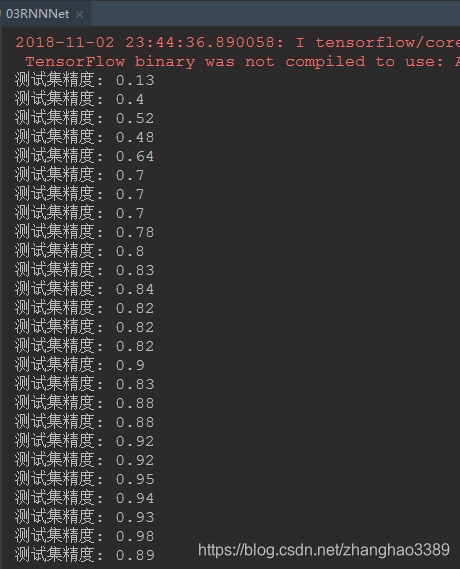MNIST資料集手寫體識別(RNN實現)
阿新 • • 發佈:2018-11-03
本章所需知識:
- 沒有基礎的請觀看深度學習系列視訊
- tensorflow
Python基礎
資料下載連結:
MNIST資料集手寫體識別(CNN實現)
import tensorflow as tf import tensorflow.examples.tutorials.mnist.input_data as input_data # 匯入下載資料集手寫體 mnist = input_data.read_data_sets('../MNIST_data/', one_hot=True) class RNNNet: # 建立一個RNNNet類 def __init__(self): self.x = tf.placeholder(dtype=tf.float32, shape=[None, 28, 28], name='input_x') # 建立資料佔位符 self.y = tf.placeholder(dtype=tf.float32, shape=[None, 10], name='input_y') # 建立標籤佔位符 self.fc_w1 = tf.Variable(tf.truncated_normal(shape=[128, 10], dtype=tf.float32, stddev=tf.sqrt(1 / 10), name='fc_w1')) # 定義 輸出層/全連結層 w self.fc_b1 = tf.Variable(tf.zeros(shape=[10]), dtype=tf.float32, name='fc_b1') # 定義 輸出層/全連結層 偏值b # 前向計算 def forward(self): cell = tf.nn.rnn_cell.BasicLSTMCell(128) # 建立128個LSTM的RNN結構(細胞結構) state1 = cell.zero_state(100, dtype=tf.float32) # 初始化細胞的狀態為 0, 傳入初始化批次 和資料型別 self.rnn_ouput, self.state = tf.nn.dynamic_rnn(cell, self.x, initial_state=state1, time_major=False) # 將細胞cell 和資料 self.x 初始化狀態傳入RNN細胞結構 獲得兩個返回值 output 和 狀態state self.fc1 = tf.matmul(self.rnn_ouput[:, -1, :], self.fc_w1) + self.fc_b1 # 取rnn_output的輸出狀態的 每個輸出的最後一行 進行全連結計算 self.output = tf.nn.softmax(self.fc1) # 將全連結計算後的結果進行 softmax分類 # 後向計算 def backward(self): # 求出網路的 cost值(損失) self.cost = tf.reduce_mean(tf.nn.softmax_cross_entropy_with_logits(labels=self.y, logits=self.fc1, name='cost')) # 使用AdamOptimizer優化器優化 self.cost self.opt = tf.train.AdamOptimizer().minimize(self.cost) # # 計算測試集識別精度 def acc(self): # 將預測值 output 和 標籤值 self.y 進行比較 self.acc1 = tf.equal(tf.argmax(self.output, 1), tf.argmax(self.y, 1)) # 最後對比較出來的bool值 轉換為float32型別後 求均值就可以看到滿值為 1的精度顯示 self.accaracy = tf.reduce_mean(tf.cast(self.acc1, tf.float32)) if __name__ == '__main__': net = RNNNet() # 啟動tensorflow繪圖的RNNNet net.forward() # 啟動前向計算 net.backward() # 啟動後向計算 net.acc() # 啟動精度計算 init = tf.global_variables_initializer() # 定義初始化tensorflow所有變數操作 with tf.Session() as sess: # 建立一個Session會話 sess.run(init) # 執行init變數內的初始化所有變數的操作 for i in range(10000): # 訓練10000次 ax, ay = mnist.train.next_batch(100) # 從mnist資料集中取資料出來 ax接收圖片 ay接收標籤 ax_batch = ax.reshape([-1, 28, 28]) # 將取出的 圖片資料 reshape成 NSV 結構 loss, output, accaracy, _ = sess.run(fetches=[net.cost, net.output, net.accaracy, net.opt], feed_dict={net.x: ax_batch, net.y: ay}) # 將資料喂進RNN網路 # print(loss) # 列印損失 # print(accaracy) # 列印訓練精度 if i % 10 == 0: # 每訓練10次 test_ax, test_ay = mnist.test.next_batch(100) # 則使用測試集對當前網路進行測試 test_ax_batch = sess.run(tf.reshape(test_ax, [-1, 28, 28])) # 將取出的 圖片資料 reshape成 NSV 結構 test_output = sess.run(fetches=net.output, feed_dict={net.x: test_ax_batch}) # 注意fetches=[net.output]加了中括號返回值會變為list # 將測試資料喂進網路 接收一個output值 test_acc = tf.equal(tf.argmax(test_output, 1), tf.argmax(test_ay, 1)) # 對output值和標籤y值進行求比較運算 test_accaracy = sess.run(tf.reduce_mean(tf.cast(test_acc, tf.float32))) # 求出精度的準確率進行列印 print(test_accaracy) # 列印當前測試集的精度
最後附上訓練截圖:

